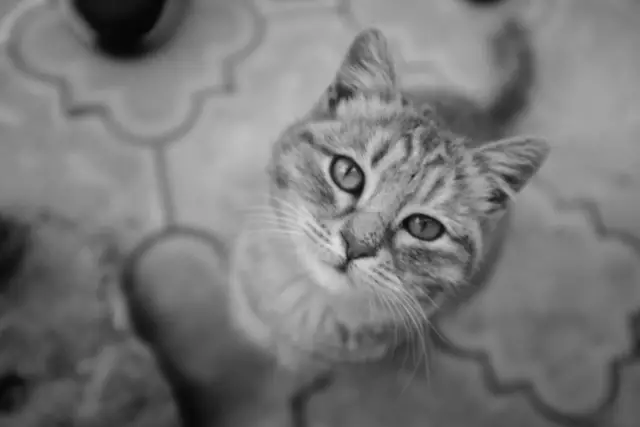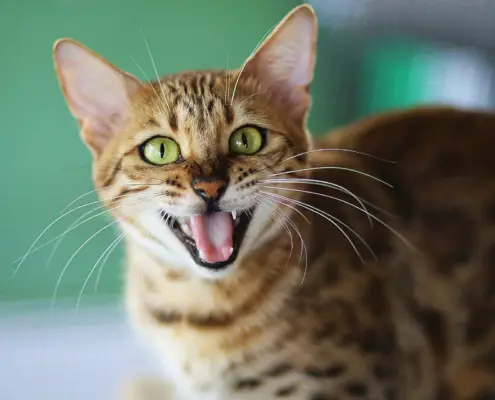
Cats have long been fascinating creatures, captivating us with their enigmatic behavior. Whether it’s their graceful movements, independent nature, or mysterious ways, there’s no denying that cats have a unique charm. Understanding feline behavior is a topic that has intrigued pet owners, researchers, and cat lovers alike. In this article, we will delve into one specific behavior that has puzzled many: why do cats chase lasers?
Understanding the Predatory Instinct in Cats
To comprehend why cats chase lasers, it’s essential to explore their innate predatory instinct. Cats are natural-born hunters, descended from their wild ancestors. This instinctive behavior is deeply ingrained in their DNA, and while domestication has brought about changes in their lifestyles, their hunting instincts remain intact.
When a cat spots a laser pointer’s bright red dot dancing across the floor or walls, it triggers their prey drive. Their predatory instincts kick in, compelling them to stalk and pounce on the “prey.” The laser mimics the quick movements of small animals, activating the cat’s hunting behavior and stimulating their senses.
Why Do Cats Chase Lasers?
The allure of lasers for cats lies in their ability to replicate the elusive movements of prey. Cats are masters of visual tracking, and the laser’s rapid, unpredictable motion taps into their natural instincts. The quick reflexes required to chase and catch prey are harnessed during laser play, providing mental and physical stimulation for cats.
Furthermore, the laser’s red dot triggers cats’ predatory response due to its resemblance to small, moving creatures. Cats are drawn to fast, erratic movements, and the laser’s swift motion replicates these characteristics. The combination of the red dot’s movement and the cat’s innate prey drive creates an irresistible urge to chase.
The Science Behind Cats’ Attraction to Lasers
The science behind cats’ attraction to lasers lies in their unique visual system. Cats possess extraordinary vision, with a keen ability to detect motion and perceive depth. They have a higher number of rod cells in their eyes, specialized for detecting movement, especially in low light conditions.
When a laser moves across a surface, it triggers the cat’s rod cells, which are highly sensitive to changes in light and motion. This visual stimulation activates the cat’s brain, releasing neurotransmitters associated with pleasure and excitement. It’s a thrilling experience for them, and the chase becomes a rewarding game.
Benefits of Laser Play for Cats
Engaging in laser play offers numerous benefits for cats, both mentally and physically. Firstly, it provides an outlet for their natural hunting instincts, fulfilling their need for mental stimulation. This type of play encourages cats to exercise and engage in physical activity, which is vital for their overall health and well-being.
Laser play also helps build a strong bond between cats and their owners. By actively participating in playtime, pet owners can establish a deeper connection with their feline companions. It becomes an opportunity for interactive play, strengthening the human-animal bond and providing a source of entertainment for both parties involved.
Potential Risks of Laser Play for Cats
While laser play can be enjoyable and beneficial, it’s crucial to be aware of potential risks associated with this activity. One potential risk is the frustration that cats may experience when they are unable to catch or capture the elusive laser dot. This frustration can lead to stress and anxiety in some cats, especially if they are unable to fulfill their natural instinct to capture prey.
Another risk is the possibility of over-stimulation during laser play. Cats can become hyper-focused on the laser dot, which may lead to obsessive behavior or compulsive tendencies. It’s essential to monitor your cat’s behavior during playtime and ensure that they have opportunities for other forms of physical and mental stimulation.
Alternatives to Laser Play for Cats
If you’re concerned about the potential risks associated with laser play or simply want to provide your cat with alternative forms of stimulation, there are several options to consider. Interactive toys, such as wand toys or puzzle feeders, can engage your cat’s hunting instincts and provide mental and physical exercise.
Creating a stimulating environment with scratching posts, climbing trees, and interactive play areas can also satisfy your cat’s need for exploration and play. Additionally, incorporating scent enrichment, such as catnip or silver vine, can provide sensory stimulation and enhance your cat’s overall well-being.
Tips for Safe and Enjoyable Laser Play with Cats
If you decide to engage in laser play with your cat, there are a few essential tips to ensure a safe and enjoyable experience. Firstly, never shine the laser directly into your cat’s eyes, as it can cause damage to their sensitive vision. Instead, aim the laser dot at the floor or walls, allowing your cat to chase and pounce on it without looking directly into the light.
Secondly, always conclude the laser play session with a physical toy or treat that your cat can capture. This helps satisfy their instinctual need to catch prey, preventing frustration or unfulfilled desires. Lastly, it’s crucial to balance laser play with other forms of play and stimulation to provide a well-rounded experience for your cat.
Exploring Other Curious Feline Behaviors
While laser play is just one aspect of feline behavior, cats exhibit a myriad of other curious behaviors that continue to fascinate us. From kneading blankets to chirping at birds through windows, cats never fail to surprise and entertain us with their unique quirks. Understanding these behaviors not only deepens our bond with our feline companions but also allows us to provide them with the care and enrichment they need.
Conclusion
The mystery behind why cats chase lasers boils down to a combination of their innate predatory instincts and the laser’s ability to replicate the movement of prey. Through laser play, cats can engage in mental and physical stimulation, fulfilling their natural hunting instincts. However, it’s important to be aware of potential risks and to provide alternative forms of play and stimulation to ensure a well-rounded and satisfying experience for our feline friends. By decoding their behaviors, we can better understand and appreciate the fascinating world of cats. So, next time you see a cat chasing a laser, remember that it’s more than just a playful game—it’s a glimpse into their wild ancestry and a testament to their incredible hunting prowess.
If you enjoyed my article, I would appreciate you sharing it with your network.

Sima Ndlebe
Sima writes for CatBuzz. He is interested in Cats, Health and Fitness, and Entrepreneurship.
Published: 16 November 2023



